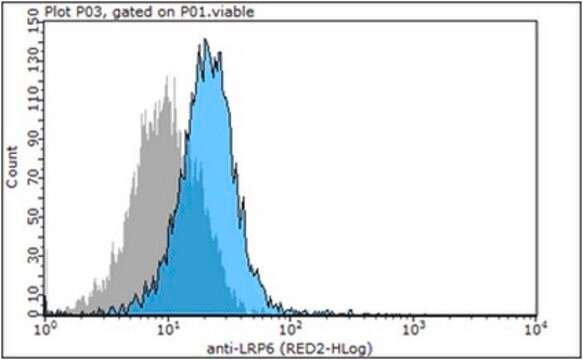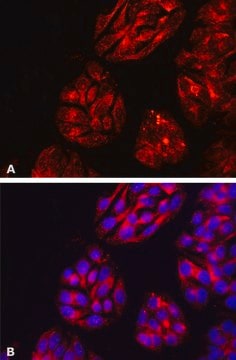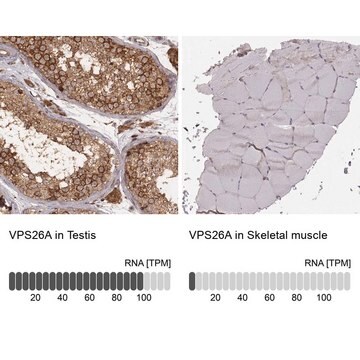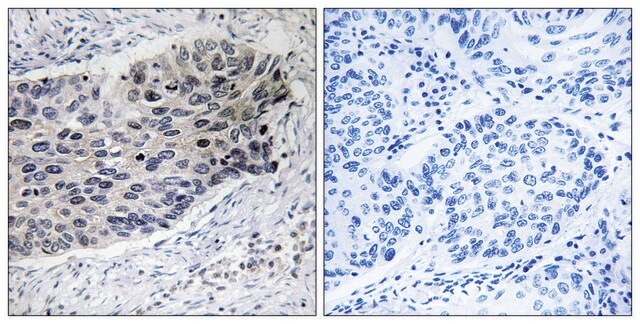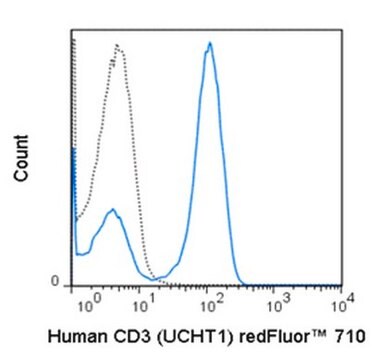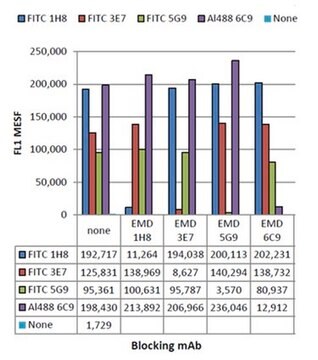CBL150-I
Anti-CD3e Antibody, clone UCHT1
clone UCHT1, from mouse
Synonym(e):
T-cell surface glycoprotein CD3 epsilon chain, CD3-epsilon, CD3e, T-cell surface antigen T3/Leu-4 epsilon chain
About This Item
Empfohlene Produkte
Biologische Quelle
mouse
Qualitätsniveau
Antikörperform
purified immunoglobulin
Antikörper-Produkttyp
primary antibodies
Klon
UCHT1, monoclonal
Speziesreaktivität
human
Methode(n)
ELISA: suitable
flow cytometry: suitable
immunocytochemistry: suitable
immunohistochemistry: suitable
immunoprecipitation (IP): suitable
Isotyp
IgG1κ
NCBI-Hinterlegungsnummer
UniProt-Hinterlegungsnummer
Versandbedingung
dry ice
Posttranslationale Modifikation Target
unmodified
Angaben zum Gen
human ... CD3E(916)
Allgemeine Beschreibung
Spezifität
Immunogen
Anwendung
Entzündung & Immunologie
Immunologische Signalübertragung
ELISA Analysis: A representative lot was used as the capture antibody for the detection of epsilon-associated TCR complex proteins by sandwich ELISA (Poggi, A., et al. (1996). Int. Immunol. 8(12):1947-1953).
Immunocytochemistry Analysis: A representative lot detected the exogensously expressed human CD3 epsilon chain on the surface of murine T cells by flourescent immunocytochemistry (Clevers, H., et al. (1988). Eur. J. Immunol. 18(5):705-710).
Immunocytochemistry Analysis: A representative lot was employed to determined the plasma membrane and cytoplasmic CD3 immunoreactivity in T cell populations and T-ALL blast cells by flourescent immunocytochemistry (Campana, D., et al. (1987). J. Immunol. 138(2):648-655).
Immunohistochemistry Analysis: A representative lot detected CD3+ T cells (T3+) in the periglandular stromal aggregates in frozen dometrium sections from female donors undergone routine dilation and curettage procedures (Kamat, B.R., and Isaacson, P.G. (1987). Am. J. Pathol. 127(1):66-73).
Affects Function: A representative lot induced surface IL-2R expression and proliferation of human peripheral blood T lymphocytes (Van Wauwe, J.P., et al. (1984). J. Immunol. 133(1):129-132).
Flow Cytometry Analysis: A representative lot was employed for fluorescence activated cell sorting (FACS) of CD3+ human lymphocytes (Beverley, P.C., and Callard, R.E. (1981). Science. 11(4):329-334).
Qualität
Flow Cytometry Analysis: 0.1 µg of this antibody detected CD3e in 1X10E6 human PBMC.
Zielbeschreibung
Physikalische Form
Lagerung und Haltbarkeit
Handling Recommendations: Upon receipt and prior to removing the cap, centrifuge the vial and gently mix the solution. Aliquot into microcentrifuge tubes and store at -20°C. Avoid repeated freeze/thaw cycles, which may damage IgG and affect product performance.
Sonstige Hinweise
Haftungsausschluss
Sie haben nicht das passende Produkt gefunden?
Probieren Sie unser Produkt-Auswahlhilfe. aus.
Empfehlung
Lagerklassenschlüssel
12 - Non Combustible Liquids
WGK
WGK 2
Flammpunkt (°F)
Not applicable
Flammpunkt (°C)
Not applicable
Analysenzertifikate (COA)
Suchen Sie nach Analysenzertifikate (COA), indem Sie die Lot-/Chargennummer des Produkts eingeben. Lot- und Chargennummern sind auf dem Produktetikett hinter den Wörtern ‘Lot’ oder ‘Batch’ (Lot oder Charge) zu finden.
Besitzen Sie dieses Produkt bereits?
In der Dokumentenbibliothek finden Sie die Dokumentation zu den Produkten, die Sie kürzlich erworben haben.
Unser Team von Wissenschaftlern verfügt über Erfahrung in allen Forschungsbereichen einschließlich Life Science, Materialwissenschaften, chemischer Synthese, Chromatographie, Analytik und vielen mehr..
Setzen Sie sich mit dem technischen Dienst in Verbindung.